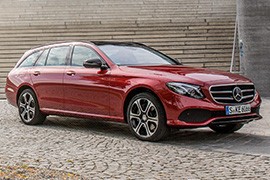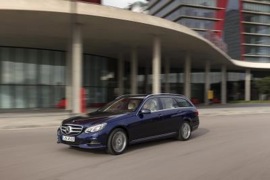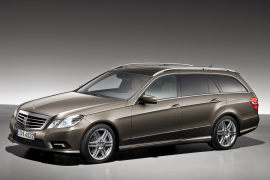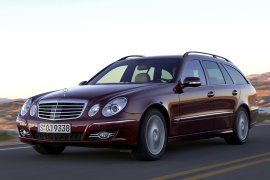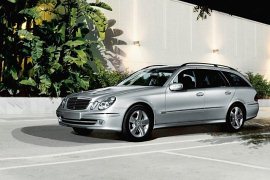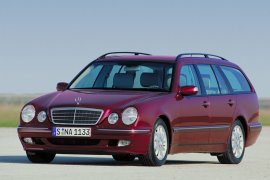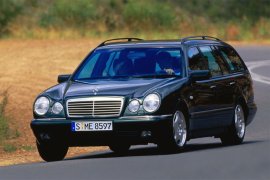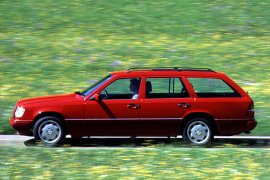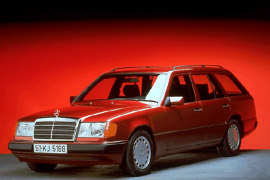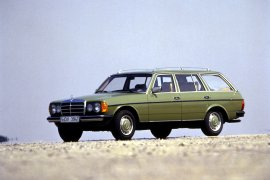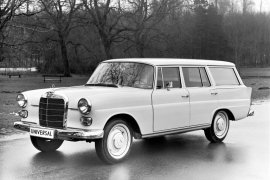MERCEDES BENZ E-Klasse T-Modell Models/Series Timeline, Specifications & Photos
First production year: 1965
Engines: Gasoline, Diesel, Hybrid diesel
Body style: Wagon (station wagon, estate, combi, touring)
In 2016, Mercedes-Benz introduced a new generation for its famous E-Class lineup and made it available in two shapes: sedan and station wagon. The latter version was one of the most spacious vehicles in its segment and offered a unique option, such as a pair of jump seats for children in the trunk.
But that was not the only reason why the E-Class station wagon was famous. It combined the comfort of a luxury car, the versatility of a crossover, and the fuel efficiency needed by a taxi driver. Furthermore, it came packed with technology.
With a design language characterized by curved lines and waved shapes, the E-Class station wagon featured a front fascia where a pair of LED headlights flanked a broad grille adorned by a chromed rim and three slats that crossed it. Customers could also order the car with an AMG package that added an aggressive-looking bumper fitted with an A-shaped lower grille and massive side scoops that flanked it.
From its profile, the 2016 E-Class (S213) shared its front side, up to the B-pillar with its sedan sibling. After that point, the extended roof was slightly sloped down toward the tailgate, which featured a racked-forward window and a spoiler above it. The automaker offered the car with a standard power tailgate that eased access to the cavernous trunk.
Inside, the luxurious cabin was nothing short of what the sedan version offered. Depending on the grades and options, customers could order the car with a dual-screen atop the dashboard: one for the instrument panel and the other for the infotainment system. There were also a few options for the seats.
The base models came fitted with cloth upholstery and mild bolstering on the sides, while those who opted for the AMG package got them with high-bolstered areas and leather upholstery. The center console that separated the front occupants housed a couple of storage areas and the controller for the MBUX infotainment unit. Behind them, on the split-folding (40/20/40) bench seat, it was room enough for three adults, but the middle-seated one had to cope with the tall transmission tunnel. Out back, in the trunk, Mercedes-Benz offered a storage area of 670 liters (23.7 cu-ft.) that could be expanded by folding down the rear seats up to 1,820 liters (64.3 cu-ft).
Mercedes-Benz installed a wide choice of diesel and gasoline engines under the E-Class station wagon’s hood ranging between 150 PS (148 hp) and 333 PS (328 hp) that sent their power via a nine-speed automatic gearbox to the rear or in all corners, depending on the version. Unlike the sedan version, the station wagon came fitted as standard with adaptive pneumatic suspension for the rear axle, which helped it stay leveled even under full load.
In 2013 Mercedes-Benz introduced a heavily restyled version of its well-known E-Class, and along with the sedan and coupe versions, the station wagon was updated as well.
When the fourth generation of the E-Class broke covers in 2009, the carmaker's fans were enraged. After two generations fitted with round headlights (W210 and W211), the W212 featured squared-looking ones, and they didn't like it. So, back to the drawing board for Mercedes-Benz's design team. Still, the automaker didn't rush and launched the improved version as it was scheduled in late 2012.
This time, the team did its homework and prepared a properly-looking Mercedes-Benz. The refreshed version got a new front fascia with two swept-back headlights. In addition, the hood and the front bumper were redesigned. The latter was also available with an AMG styling for those looking for a more aggressive-looking vehicle. From its sides, the new fenders and quarter panels lost the enlarged areas, which created other controversies among the brand's fans. In the longroof version, the car got darkened B- and C-pillars, inducing the idea of a shooting brake. Finally, at the back, most versions were fitted with two side exhausts, further emphasizing the idea of a sporty and elegant station wagon.
Inside, the completely redesigned dashboard featured an integrated infotainment system placed atop the center stack. Still, it wasn't available with a touchscreen function, and it could've been operated via a controller placed on the center console. The cars fitted with automatic transmissions had the gear selector mounted behind the steering wheel, as a stalk, instead of a regular lever mounted between the front seats. At the back, the split-folding bench increased the trunk area, while the extended roof offered more headroom.
Another significant upgrade was for gearboxes, which were either six-speed manuals or seven-speed automatics.
MERCEDES BENZ E-Klasse T-Modell (S212) E 200 6MT RWD (184 HP)
MERCEDES BENZ E-Klasse T-Modell (S212) E 200 7AT RWD (184 HP)
MERCEDES BENZ E-Klasse T-Modell (S212) E 250 7AT RWD (211 HP)
MERCEDES BENZ E-Klasse T-Modell (S212) E 300 4Matic 7AT AWD (252 HP)
MERCEDES BENZ E-Klasse T-Modell (S212) E 300 7AT RWD (252 HP)
MERCEDES BENZ E-Klasse T-Modell (S212) E 350 4Matic 7AT AWD (306 HP)
MERCEDES BENZ E-Klasse T-Modell (S212) E 350 7AT RWD (306 HP)
MERCEDES BENZ E-Klasse T-Modell (S212) E 400 4Matic 7AT AWD (333 HP)
MERCEDES BENZ E-Klasse T-Modell (S212) E 400 7AT RWD (333 HP)
MERCEDES BENZ E-Klasse T-Modell (S212) E 500 4Matic 7AT AWD (408 HP)
MERCEDES BENZ E-Klasse T-Modell (S212) E 500 7AT RWD (408 HP)
MERCEDES BENZ E-Klasse T-Modell (S212) E 200 CDI 6MT RWD (136 HP)
MERCEDES BENZ E-Klasse T-Modell (S212) E 200 CDI 7AT RWD (136 HP)
MERCEDES BENZ E-Klasse T-Modell (S212) E 220 CDI 6MT RWD (170 HP)
MERCEDES BENZ E-Klasse T-Modell (S212) E 220 CDI 7AT RWD (170 HP)
MERCEDES BENZ E-Klasse T-Modell (S212) E 250 CDI 4Matic 7AT AWD (204 HP)
MERCEDES BENZ E-Klasse T-Modell (S212) E 250 CDI 6MT RWD (204 HP)
MERCEDES BENZ E-Klasse T-Modell (S212) E 250 CDI 7AT RWD (204 HP)
MERCEDES BENZ E-Klasse T-Modell (S212) E 300 BlueTec 7AT RWD (231 HP)
MERCEDES BENZ E-Klasse T-Modell (S212) E 350 BlueTec 4Matic 7AT AWD (252 HP)
MERCEDES BENZ E-Klasse T-Modell (S212) E 350 BlueTec 7AT RWD (252 HP)
MERCEDES BENZ E-Klasse T-Modell (S212) E 350 BlueTec 9AT RWD (252 HP)
MERCEDES BENZ E-Klasse T-Modell (S212) E 300 BlueTec Hybrid 7AT AWD (204 HP)
Mercedes-Benz introduced a new generation of the E-Class in 2009 and shook the customers with the new headlight design, but calmed them with the technologies that came with the car.
The E-Class wasn't the most reliable car in its class nor the fastest, but the whole package helped the German automaker sell more than half a million in less than three years since the launch of the model. Also, since the carmaker was known for its spacious station wagons, it was necessary to offer one on the market, and that came in 2009 for the Europeans in 2010 for the U.S. customers.
With a new design language at the front that showed four rectangular headlights, the 2009 E-Class range was unusual. While most other manufacturers have chosen single headlamps, Mercedes-Benz was bolder in terms of design. That was unusual for the German automaker. From its profile, the station wagon sported the same sculptured fenders and door panels as its sedan cousin. Also, the darkened B- and C-pillars left the impression of a shooting brake, amplified by the raked-forward tailgate. The carmaker installed standard LED taillights at the back for a distinctive appearance.
Inside, Mercedes-Benz introduced a new styling for the dashboard, with sharper lines and an extended cover for the infotainment screen that sat atop the center stack. The front bucket seats were separated by a wide center console that hosted a storage compartment under the armrest. The carmaker added a split-folding bench at the back that could extend the trunk area up to 1,950 liters (68.9 cu-ft).
Under the hood, the carmaker offered a wide choice of Euro 5 diesel and gasoline engines. Some versions were available with a manual transmission, while a seven-speed automatic was on the options list. Moreover, the E-Class T-Model was provided with either rear- or an all-wheel drive system.
MERCEDES BENZ E-Klasse T-Modell (S 212) 200 BlueEFFICIENCY 6MT (184 HP)
MERCEDES BENZ E-Klasse T-Modell (S 212) 200 BlueEFFICIENCY 7AT (184 HP)
MERCEDES BENZ E-Klasse T-Modell (S 212) 200 CGI 5AT (184 HP)
MERCEDES BENZ E-Klasse T-Modell (S 212) 200 CGI 6MT (184 HP)
MERCEDES BENZ E-Klasse T-Modell (S 212) 250 BlueEFICIENCY 7AT (204 HP)
MERCEDES BENZ E-Klasse T-Modell (S 212) 250 CGI 5AT (204 HP)
MERCEDES BENZ E-Klasse T-Modell (S 212) 300 BlueEFICIENCY 4MATIC 7AT (252 HP)
MERCEDES BENZ E-Klasse T-Modell (S 212) 300 BlueEFICIENCY 7AT (252 HP)
MERCEDES BENZ E-Klasse T-Modell (S 212) 350 BlueEFFICIENCY 4MATIC 7AT (306 HP)
MERCEDES BENZ E-Klasse T-Modell (S 212) 350 BlueEFFICIENCY 7AT (306 HP)
MERCEDES BENZ E-Klasse T-Modell (S 212) 350 CGI 4MATIC 7AT (292 HP)
MERCEDES BENZ E-Klasse T-Modell (S 212) 350 CGI 7AT (292 HP)
MERCEDES BENZ E-Klasse T-Modell (S 212) 500 7AT (388 HP)
MERCEDES BENZ E-Klasse T-Modell (S 212) 500 BlueEFFICIENCY 4MATIC 7AT (408 HP)
MERCEDES BENZ E-Klasse T-Modell (S 212) 500 BlueEFFICIENCY 7AT (408 HP)
MERCEDES BENZ E-Klasse T-Modell (S 212) 200 CDI 6MT (136 HP)
MERCEDES BENZ E-Klasse T-Modell (S 212) 200 CDI 7AT (136 HP)
MERCEDES BENZ E-Klasse T-Modell (S 212) 220 CDI 5AT (170 HP)
MERCEDES BENZ E-Klasse T-Modell (S 212) 220 CDI 6MT (170 HP)
MERCEDES BENZ E-Klasse T-Modell (S 212) 220 CDI 7AT (170 HP)
MERCEDES BENZ E-Klasse T-Modell (S 212) 250 CDI 4MATIC 7AT (204 HP)
MERCEDES BENZ E-Klasse T-Modell (S 212) 250 CDI 6MT (204 HP)
MERCEDES BENZ E-Klasse T-Modell (S 212) 250 CDI 7AT (204 HP)
MERCEDES BENZ E-Klasse T-Modell (S 212) 300 CDI BlueEFFICIENCY 7AT (231 HP)
MERCEDES BENZ E-Klasse T-Modell (S 212) 350 Bluetec 7AT (211 HP)
MERCEDES BENZ E-Klasse T-Modell (S 212) 350 CDI 4MATIC 7AT (231 HP)
MERCEDES BENZ E-Klasse T-Modell (S 212) 350 CDI 7AT (231 HP)
MERCEDES BENZ E-Klasse T-Modell (S 212) 350 CDI BlueEFFICIENCY 4MATIC 7AT (265 HP)
MERCEDES BENZ E-Klasse T-Modell (S 212) 350 CDI BlueEFFICIENCY 7AT (265 HP)
MERCEDES BENZ E-Klasse T-Modell (S 212) 300 BlueTEC Hybrid 7AT (231 HP)
After four years on the market, the third generation of the E-Class was refreshed with a well-deserved facelift and around 2000 components changed to the car.
The facelifted E-Class Estate (Station-wagon), was released at the 2006 New York International Auto Show. One of the first big surprises for the customers was that the base prices for the four and six-cylinder units remained the same as before, even though the base diesel version gained 20 more horsepower.
On the outside, the E-Class received a new bumper and grille that featured a distinctive sweepback. Mercedes-Benz enhanced the details of the twin-headlamp fascia, with a transparent upper side for a better lightning pattern. In the back, the S211 E-Class station-wagon receiver LEDs for sidelights. A new set of side sills and rear bumper was installed for the Avantgarde trim level.
On the inside, there was a new steering wheel, and the climate control system Thermatic was fitted as standard on all the range. New materials and colors were added to the options list.
The most important modifications were made under the skin. For the brakes, the facelift introduced the Adaptive brake system instead of the Sensotronic Brake Control. For the engines, the customers had a choice of thirteen versions. Six of them were new or further developed. The new top-of-the-line engine was the 5.5-liter V8 in the E 500.
The second generation of the four-eye Mercedes-Benz E-Class was introduced in 2002 at the Brussels Motor Show and the station-wagon version, named T-Model, was unveiled in October 2003.
Mercedes-Benz understood that, sometimes, a step back is the best step. That is why the 2003 T-Model variant of the E-Class was shorter than its predecessor. It didn't offer as much trunk-space or interior room, but from the utility point of view, it was better for its customers. It was easier to park but it still offered enough room for passengers.
The 2003 E-Class T-Model featured the same twin-lamps design for its headlights, like its predecessor, but the entire front fascia was tilted rearwards or a better aerodynamic. Its raked A-pillars and sloped end confirmed the company tends to make its cars more fuel-efficient.
Inside, there was the same front slightly bolstered seats. For the rear passengers, there was enough room both for head and legs, due to its long, 2.9 (112.4”) wheelbase. The split rear-seats backseat could have been folded to increase the trunk space. For better climate comfort, the car-manufacturer installed air-vents for the rear passengers, in the rear part of the center console.
Under the hood, Mercedes-Benz offered gasoline and diesel engines. It was fitted with a 5- and 6-speed manual or 5-speed automatic. The E350 and the E500 were offered with the new, 7-speed automatic transmission. The E55 AMG was exclusively offered with the 5G-Tronic automatic. The E-Class T-Model was offered also with an all-wheel-drive system.
MERCEDES BENZ E-Klasse T-Modell (S211) 200 Kompressor 6MT RWD (163 HP)
MERCEDES BENZ E-Klasse T-Modell (S211) 240 V6 6M RWD (177 HP)
MERCEDES BENZ E-Klasse T-Modell (S211) 280 V6 6MT RWD (231 HP)
MERCEDES BENZ E-Klasse T-Modell (S211) 320 V6 5AT RWD (224 HP)
MERCEDES BENZ E-Klasse T-Modell (S211) 350 V6 7AT RWD (272 HP)
MERCEDES BENZ E-Klasse T-Modell (S211) 500 V8 7AT RWD (306 HP)
MERCEDES BENZ E-Klasse T-Modell (S211) 220 CDI 6MT RWD (152 HP)
MERCEDES BENZ E-Klasse T-Modell (S211) 270 CDI 6MT RWD (177 HP)
MERCEDES BENZ E-Klasse T-Modell (S211) 280 CDI V6 6MT RWD (190 HP)
MERCEDES BENZ E-Klasse T-Modell (S211) 320 CDI V6 5AT RWD (204 HP)
MERCEDES BENZ E-Klasse T-Modell (S211) 320 CDI V6 7AT RWD (224 HP)
Besides its sedan sibling, the station wagon version of the first generation of the E-Class got a well-deserved facelift as well in 1999.
By 1999, customers started to like the four-headlights system adopted by Mercedes-Benz instead of the former rectangular-shaped ones used on the W124 model. Yet, there were new emission standards to meet in Europe, and the German carmaker needed to upgrade its engines to comply. In addition, it made some other changes to the car's exterior and interior look.
By 1999, Mercedes-Benz's marketing strategy proved it was right when it considered that the four-headlights design would attract customers from other brands, so instead of changing them, the design team just reshaped them a little to give them a modern look. Thanks to the Xenon lights, available as an option, the drivers were happier than before during night driving. Another upgrade was the introduction of blinkers into the door mirror caps, a feature that was unusual for those times. At the back, the tailgate remained the same, but the taillights were slightly redesigned but kept the same shape.
Inside, there were additional upgrades, and the steering wheel received buttons for the infotainment system. Moreover, Mercedes-Benz introduced a navigation system with an LCD on the center stack. Another upgrade, this time for the entire range, was for the vents, which were redesigned. One thing that didn't change was the cargo area, which remained the same at 600 liters (21.2 cu-ft.) with the rear seats up and 1,975 liters (68.7 cu-ft.) with the entire bench folded.
Under the hood, all the old engines were either dropped or upgraded to comply with the Euro 5 emission standards. Moreover, an improved five-speed automatic transmission added more comfort, thanks to its smooth gear changes.
MERCEDES BENZ E-Klasse T-Modell (S210) 200 6MT RWD (136 HP)
MERCEDES BENZ E-Klasse T-Modell (S210) 200 Kompressor 6MT RWD (163 HP)
MERCEDES BENZ E-Klasse T-Modell (S210) 240 6MT RWD (170 HP)
MERCEDES BENZ E-Klasse T-Modell (S210) 280 6MT RWD (204 HP)
The 1996 Mercedes-Benz E-Class faced a huge controversy over its design and, most importantly, over its front fascia that showed a distinct, four-headlights layout instead of the previously used squared-looking headlamps.
But the carmaker didn't really care about what the market said since customers started to place their orders. After all, it was a new mid-size Mercedes-Benz, and, like its predecessors, it had to come in a station wagon shape as well.
With the new design, Mercedes-Benz threw out of the window most of its older design books. All the previous sharp lines penned on the W124 model were replaced by curved ones. Neither of the body panels looked flat and straight. Moreover, even the hood showed fluid lines, following the biodesign trend of the mid-90s. In the station wagon shape, the E-Class T-Model offered a long roof curved downward at the back. A third window was added on each side behind the rear doors. Customers also had the option to buy roof rails. In the base trim level, the car was fitted with steel wheels, while the upper trim levels were fitted as standard with alloys.
The interior featured an elegant design, with wood inserts on the dashboard, center console, and door cards, depending on the trim level. At the front, the carmaker installed bucket seats designed for comfort, while the curved dashboard provided an airbag for the side passenger. Also, the driver could enjoy the benefits of an airbag. In the back, Mercedes-Benz installed a split-folding bench that expanded the trunk from an impressive 600 liters (21.2 cu. ft.) to a staggering 1,975 liters (68.7 cu.ft.).
Under the hood, the carmaker offered the car with a choice of diesel and gasoline engines mated to either a manual or, as an option, a five-speed automatic.
MERCEDES BENZ E-Klasse T-Modell (S210) 200 5MT RWD (136 HP)
MERCEDES BENZ E-Klasse T-Modell (S210) 230 5MT RWD (150 HP)
MERCEDES BENZ E-Klasse T-Modell (S210) 240 5MT RWD (170 HP)
MERCEDES BENZ E-Klasse T-Modell (S210) 280 V6 6MT RWD (204 HP)
MERCEDES BENZ E-Klasse T-Modell (S210) 320 V6 5AT RWD (224 HP)
MERCEDES BENZ E-Klasse T-Modell (S210) 420 V8 5AT RWD (279 HP)
MERCEDES BENZ E-Klasse T-Modell (S210) 430 V8 5AT RWD (279 HP)
Mercedes-Benz updated the E-Class W124 range in 1993, nine years after the model's introduction on the market, and the station wagon was updated as well.
Between 1984 and 1997, the German car manufacturer sold over 2.5 million units of this range, which was available as a sedan, a six-door limousine, a station wagon, a coupe, and a convertible. In the first production year, the E-Class was available only as a four-door sedan, followed by the T-Modell (S124) in 1985. Come 1993, and the entire lineup was refreshed to comply with the Euro 1 emission standards, which came into force starting January of that year.
The car's front was restyled and featured new headlights with an angled-down inner area. Its corner-mounted turn signals sported clear lenses instead of the formerly used amber ones. The automaker also considered that there was no deed for rubber protection over bumpers, thus creating a cleaner look for the car. From its sides, the long roof E-Class had the same broad windows and the raked-forward tailgate as its predecessor. Finally, at the back, the body-colored rear bumper was redesigned.
Inside, the built quality was impressive. Even though the dashboard looked old or outdated, the wood trims, the leather, and the chromed metallic parts looked better than in any car on the market. Even though the seven-seat option was not in high demand, the automaker kept it on the offer, thus offering its car an edge over its competition.
Under the hood, the E-Class T-Modell was offered with a wide choice of gasoline or turbo-diesel engines. Depending on the version, these were paired with either a manual or an automatic transmission. A novelty for this E-Class was the all-wheel drive system, named 4Matic, in Mercedes-Benz's designation.
MERCEDES BENZ E-Klasse T-Modell (S124) E 200 5MT RWD (136 HP)
MERCEDES BENZ E-Klasse T-Modell (S124) E 220 5MT RWD (150 HP)
MERCEDES BENZ E-Klasse T-Modell (S124) E 280 5MT RWD (193 HP)
MERCEDES BENZ E-Klasse T-Modell (S124) E 300 4MATIC 4AT RWD (179 HP)
MERCEDES BENZ E-Klasse T-Modell (S124) E 320 5MT RWD (220 HP)
The station wagon demand in the '80s and, after a successful career, the S123 Series had to be retired. The new S124 stepped in and brought new technologies to fill the needs.
The E-Class T-Model was launched in September 1985 at the Frankfurt International Motor Show. It carried over most of the features and styling from its sedan sibling. The rear, of course, was different. But the technical modifications went far beyond the look.
Since it was built to carry more loads, the T-Model was equipped with the new multi-link suspension and a hydro-pneumatic level adjustment suspension. That system kept the car at the same ground level, regardless of the load. Furthermore, the front suspension had received a strut-type damper.
An interesting feature for the E-Class T-Model was the option of 7-seats. In the trunk, a folding rear-facing bench-seat was installed. It was small and could have been used only by children. To improve the safety, for all the T-Model versions, the tank was located under the trunk, and, in an event of a rear crash, it fell down from its place and secured by ropes to not touch the road.
At the time of launch, there were 8 engines available for order. The 3.0-liter diesel and the 2.6-liter gasoline from the sedan were not available. But the 143 hp 3.0-liter turbodiesel was included. Also included to order were the 4-speed automatic transmission and the all-wheel-drive 4Matic system. In 1989, the diesel engines were modified to decrease the emissions, improve the fuel-efficiency, and as a result there was also a slight power increase for the 2.0- and 2.5-liter turbodiesel engines.
MERCEDES BENZ E-Klasse T-Modell (S124) 200 4MT RWD (105 HP)
MERCEDES BENZ E-Klasse T-Modell (S124) 200 E 4MT RWD (118 HP)
MERCEDES BENZ E-Klasse T-Modell (S124) 200 E-16V 5MT RWD (136 HP)
MERCEDES BENZ E-Klasse T-Modell (S124) 220 E 5MT RWD (150 HP)
MERCEDES BENZ E-Klasse T-Modell (S124) 230 E 4MT RWD (132 HP)
MERCEDES BENZ E-Klasse T-Modell (S124) 280 E 5MT RWD (197 HP)
MERCEDES BENZ E-Klasse T-Modell (S124) 300 E 5MT RWD (179 HP)
MERCEDES BENZ E-Klasse T-Modell (S124) 300 E-24V 5MT RWD (220 HP)
MERCEDES BENZ E-Klasse T-Modell (S124) 320 E 5MT RWD (220 HP)
After successfully launching the W123 lineup in 1975, Mercedes-Benz faced another challenge: to create a station wagon on the same platform without compromising the car's qualities.
The W123 was already a reckoned and successful model in the German carmaker's inventory. Thanks to all the variations that stretched from mundane cabs to state limousines, it was a popular vehicle. But all these versions were based on the same three-box version of the car. So, in 1978, the three-pointed star brand introduced the longroof version of it: the T-Modell.
While this vehicle was not known as an E-Class, since that name was created more than a decade later, it is considered a rightful predecessor for it. In the front, the big round dual headlamps were a characteristic design of the new models. Next to the main headlamp, under a common lens, there was a smaller halogen fog lamp. Differing from that, the two top models of the series, Types 280 and 280 E, were provided with rectangular halogen wide-band headlights. Bigger bumpers were installed for the U.S. market. On its sides, the automaker showed that it didn't want to cut corners, so the rear doors were not carried over from the sedan to the station wagon. In addition, behind the slim C-pillar, it placed a third side window, while at the back, the raked-forward tailgate completed the design in a nicer way. It didn't look like a bread van at all.
Inside, the vehicle was fitted with cloth bucket seats at the front and a folding bench seat at the back. On the instrument cluster, Mercedes-Benz installed round dials and multiple gauges that offered the driver information about the engine's status. In the back, passengers were pleased by the spacious cabin. Even the middle-seated occupants on the bench had enough legroom at their disposal.
Under the hood, the automaker installed a choice of diesel and gasoline engines paired with either four- or five-speed manual gearboxes or with a four-speed automatic.
In 1965, Mercedes-Benz W110 “Heckflosse” (tailfin) received a station wagon version that enjoyed great success on some markets, while others remained almost unknown.
In 1965, the German carmaker had no intention to introduce a station wagon based on its mid-size vehicle. The Belgian company IMA was already specialized in station-wagon conversions and unveiled a modified W110 at the 1965 Brussels Motor Show in January, with the name “Universal.” In August, IMA introduced the series product with an option for an inline-six engine under the hood.
The design was similar to the original W110 model. At the front, it kept the same front fascia with a narrow and tall grille, mounted straight-up in front of the hood. The station wagon carried over its chromed, wrapped-around bumper and the entire front fascia from the W110 “Heckflosse.” Mercedes-Benz liked the idea and offered the converted vehicles in its own network in Germany. It was the same car up to the B-pillar, but its more extended roof and the side windows mounted behind the rear doors were different. In the back, the raked-forward tailgate sported a flat, rectangular rear window.
Inside, the Universal featured a similar cabin, with room for five. The folding rear-seats seatback increased both the trunk size and the loading lengths. At the front, the flat bucket seats offered adequate comfort, while the rear bench was good for up to three people.
Under the hood, the Universal version featured inline-four or inline-six engines.
